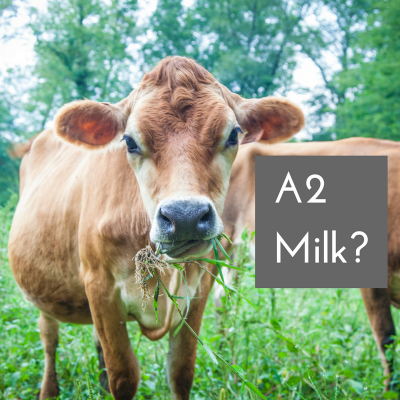Maybe you’ve noticed a new carton of A2 milk next to your go-to choice at the grocery store. Or maybe you read something about A2 milk in a magazine. But what is it?
Below, you’ll learn more about four questions:
- What’s the difference between lactose intolerance, milk protein allergy, and dairy intolerance?
- What are A1 and A2 beta-casein proteins?
- What is A2 milk?
- What does the research say about A2 milk for human consumption?
Lactose Intolerance vs. Milk Protein Allergy vs. Dairy Intolerance
Knowing the differences are key before reading on:
|
Condition |
Intolerance, Allergy, or Neither? | Can it be diagnosed with a medical test? |
| Lactose Intolerance |
Intolerance |
Yes |
| Milk Protein Allergy |
Allergy |
Yes |
| Dairy Intolerance |
Neither |
No |
Lactose Intolerance
Lactose intolerance is the inability to digest lactose. The condition lies on a continuum: Some people can drink an entire glass of milk with a meal whereas others can’t stomach milk in their coffee. This means that some people with the intolerance can digest small amounts of lactose, whereas others with the intolerance cannot.
Lactose is the naturally-occurring sugar found in milk. The sugar that isn’t digested makes its way to the large intestine, where bacteria feast on the lactose. This may cause bloating, abdominal pain, and diarrhea.
Milk Protein Allergy
A milk protein allergy is an immune response to either of the casein or whey proteins that are found in milk. For someone with an allergy, consuming any dairy may lead to hives, diarrhea, or even closure of the throat.
Dairy Intolerance
A person that has a dairy intolerance may have self-diagnosed themselves. Or, a doctor may have found that the person neither had a protein allergy nor lactose intolerance, but has discomfort after having dairy products.
Beta-Casein Proteins: The Difference Between A1 and A2
Cow’s milk contains 8 grams of protein per 8-ounce cup of milk, and approximately 30-percent of this protein is beta-casein. Two common variants of beta-casein found in cow’s milk are A1 and A2. Some cows produce milk with an equal ratio of both A1 and A2 proteins, and some cows only produce the A2 protein. Milk can be tested for the beta-casein that it contains, which is how A2 cows are found.
But there’s only one difference, and it’s at the 67th amino acid in the protein’s 209 chain: A1 beta-casein has a histidine and A2 a proline. In order for foods and drinks to be absorbed into the bloodstream, they need to broken down by digestive enzymes.
Digestion isn’t a free-for-all: Enzymes only cut when they reach a stop signal. For the A1 beta-casein, the stop signal is the histidine. Once cleaved, the fragment is called beta-casomorphin-7 (BCM-7). BCM-7 is thought by some to cause the discomfort that results from consuming dairy products by a select group of people. However, this has yet to be supported by the science.
What is A2 Milk?
A2 milk only contains the A2 beta-casein protein. A2 milk is still cow’s milk and the nutrient levels – like calcium, potassium, protein, and vitamin D – are the same.
Since A2 milk still has lactose and protein, those with a milk protein allergy should avoid it. However, a person’s severity of lactose intolerance may allow for consumption – it depends.
When compared to drinking regular cow’s milk, some people with undiagnosed dairy intolerance have reported that drinking A2 milk does not result in discomfort. These claims are person-specific.
What Does the Research Say?
Regardless of what carton you choose, know that cow’s milk is a healthful and wholesome choice. Research has linked cow’s milk consumption to improved blood pressure and reduced risk of type 2 diabetes, and may reduce risk of cardiovascular disease.
Claims that A2 milk reduces dairy-related inflammation, heart disease risk, or type 1 diabetes risk have not been supported by the science. The health benefits of A2 milk remain a theory, and more research is needed.
National Dairy Council has a great rundown of the research. You can check it out here.


